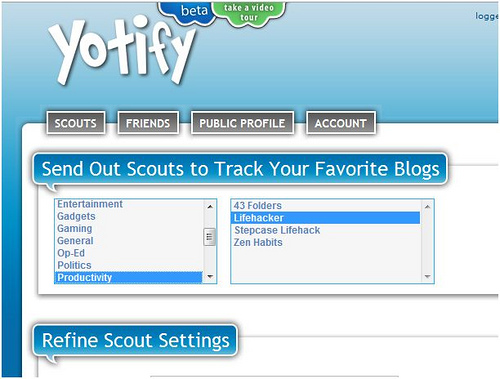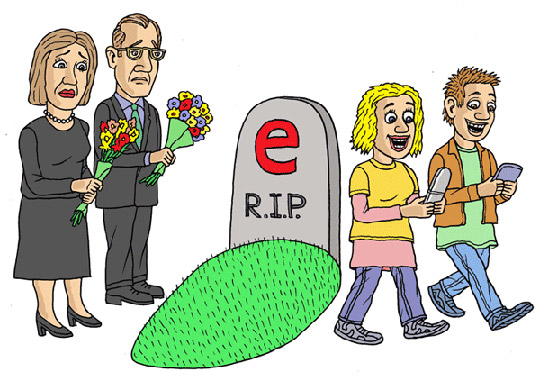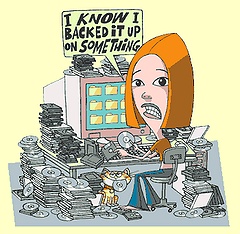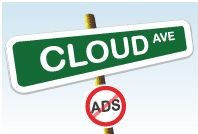Reading that TechCrunch calls Yotify “Google Alerts on Steroids” I had great expectations… that did not last long. For now, it’s a no-go… read my quick review on CloudAve.

Connecting the dots ...

Reading that TechCrunch calls Yotify “Google Alerts on Steroids” I had great expectations… that did not last long. For now, it’s a no-go… read my quick review on CloudAve.


Are we heading into Recession? The “Big R” talk of early this year quickly subsided, economic growth returned, the markets appeared to vindicate the optimists. US Presidential Candidate John McCain repeatedly said the economy was fundamentally strong… until just days ago, when he quickly switched to declaring a crisis. The Wall Street Journal says we’re in the Worst Crisis Since ’30s, With No End Yet in Sight.
 I don’t claim to be an expert economist, so whether the Big R is looming is not my call – but if you believe we’re in a strong economy, I have a bridge to sell you. Let’s just focus this discussion on how Software businesses can survive in a financial crisis, which is undeniably here.
I don’t claim to be an expert economist, so whether the Big R is looming is not my call – but if you believe we’re in a strong economy, I have a bridge to sell you. Let’s just focus this discussion on how Software businesses can survive in a financial crisis, which is undeniably here.
Not all will survive, and it’s probably healthy they won’t. Tim O’Reilly, Father-of-all-things-Web-2.0, asked the question at the Web 2.0 Expo last week:
Global warming. The U.S. losing its edge in science and technology. A growing income gap. “And what are the best and the brightest working on?” O’Reilly asked, displaying a slide of the popular Facebook application SuperPoke, which invites you to, among other things, “throw sheep” at your friends.
“Do you see a problem here?” he posed, showing another slide of the popular iPhone app “iBeer,” which simulates chugging a pint. “You have to ask yourself, are we working on the right things?”
The poster-child of the Web 2.0 boom may very well become the symbol of what went wrong:
Actually, the problem is not what they do, but how seriously they were taken. Will Price, a very smart VC said long ago:
It may well be that Slide raising $55m from mutual fund companies at $500m+ pre-money will be the “what were we thinking” moment of the current cycle.
I’m glad they did not go public, at least not a lot of people will get hurt holding the bag. But enough of what’s wrong, here’s what works:
The last point brings up the price issue. Credit will dry up. Whether we’ll officially declare Recession or not, the fear of the Big R is enough for corporate budget cuts, the disappearance of any CAPEX spending. Even worse, an entire sector almost disappeared as IT buyers. Did you know that Lehman Brothers spent over $300M on IT in just the last quarter, right before declaring bankruptcy? How do you sell in this environment?
The after-bubble nuclear period of “no IT spending at all” found me at a startup in 2001-2003. We did not exactly hit it big, but did not go under, either, and that’s because our model allowed us to get in the door way below the threshold that would have required higher authorization. Not classic SaaS, rather SES (Software Enabled Service), we were essentially data providers and often got into an “enterprise” account at $3k for the first month … eventually ramping up to annual $60-$100K. Anyone familiar with Enterprise Sales knows the term Economic Buyer: typically getting involved later at the sales cycle, approving or nuking the deal. Well, we saw no Economic Buyer: being under the threshold, we sold to the User directly.
Of course my little business is not the only proof: Salesforce.com & WebEx thrived during the last recession. The secret is the business model: pay-as-you-go. SaaS offers lower risk to enter, no initial cash layout, the subscription fees come out of OPEX vs. CAPEX, and is often approved by the User, not the mysterious Economic Buyer. The barrier of entry is much lower: once you’re in, it’s up to you to grow.
In fact I suspect the looming downturn will accelerate the structural changes in the software industry: SaaS players will thrive, traditional on-premise vendors will shrink, many will disappear.
That leaves a final point to discuss: financial solvency. For startups, it will be increasingly hard to find investors. For larger businesses the lack of late-stage investment, the credit crunch may be a serious impediment to expansion. Discover the beauty of bootstrapping – you actually get to do what you believe is right for your business, not what your Board tells you. Do less, take small steps. Frugality is key to survival. Small is beautiful will get a new meaning.
In summary, Software businesses that combine good old business sense: frugality, spending wisely, delivering value to businesses and getting paid for it, with a new business model, SaaS are likely winners in the downturn. The rest are playing musical chairs. (Oh, and the bridge is still available)
(This post originally appeared on CloudAve. Keep informed by grabbing our feed here.)

Ah, the end of the fist week! The new baby, CloudAve is 7 days old! (..and I’m alive… )
)
We launched with a discussion on Harry Debes’s famous prediction, i.e. the imminent collapse of the SaaS market in two years. I doubt he realized just how much he re-energized the entire SaaS business, analyst obeservers – he certainly sparked a healthy discussion, even including Software Icon Dave Duffield, who refuted Debes’s argument. He should know, having been on both sides of the fence. (The podcast is available on CloudAve).
 On my personal blog I don’t have to be as politically correct as on CloudAve, so here’s my summary: they tried SaaS, could not crack it, so concluded the market as a whole did not matter – a strategic mistake.. or… well, as they say, a picture says a thousand words. Ironically, the collapse of the US financial markets may just put things in a new prospective … more on this soon.
On my personal blog I don’t have to be as politically correct as on CloudAve, so here’s my summary: they tried SaaS, could not crack it, so concluded the market as a whole did not matter – a strategic mistake.. or… well, as they say, a picture says a thousand words. Ironically, the collapse of the US financial markets may just put things in a new prospective … more on this soon.
Ben compares the advent of Cloud Computing to corporate cars being replaced with allowances, while I present frustrating personal experience that could have gone smoothly using On-Demand tools.
We often talk about Cloud Computing and Software as a Service interchangeably, but are they really the same? Krish answers in a mini-series discussing the differences, i.e. segmenting out Infrastructure/Hardware as a Service (HaaS), Platform as a Service (PaaS) and Software as a Service (SaaS). In the second part of his mini-series Krish goes on a myth-busting mission, clearing up several common misunderstandings. His piece on Governor Palin’s email hijack episode could very well be considered myth-busting, too.
Dan Morrill addresses why Anti-Virus in the Cloud can offer more efficient protection and is also major relief to owners of slower computers, whose resources can be completely bogged down by the frequent Av updates and scans.
Ben, so far the most prolific author reviews Oprius, an online productivity tool for sales professionals, then proves that the second “S” in SaaS is the most important, presenting two service / help desk oriented services: Zendesk and HelpStream. He discusses NetSuite’s launch in Australia, then starts a discussion on Channels, largely triggered by another NetSuite related move – this may very well become an ongoing thread.
Talk about threads, next week we are launching a new daily feature, CloudNews – the title says it all.
If you’ve been reading CloudAve, thank you, if not, why not head over and try … or perhaps just grab our feed.
See you on Cloud Avenue next week.

Planned release? Leak? it doesn’t matter anymore, InformationWeek has just pre-announced two planned major Zoho upgrades:
Zoho Creator 3 will come with an apps marketplace, something I asked for a while ago. The App Store will allow developers set their own prices and keep 100% of the revenue. It will also become a code-to-order marketplace: if you don’t find an app you need, spec it out, and receive offers from developers.
Now for the fun part: since the Chrome Comic Book, what better way to introduce a major new offering then by a comic video?
(Update: Since the news was indeed unintentionally leaked, not released, I took off the embedded video. The 356 of you who saw it: consider it a preview. An updated version will be back @ Launch)
The other major announcement is making Zoho’s Web-based Mail service available off-line, based on Google Gears. This will no doubt give Zoho Mail a competitive edge for a while.
It’s somewhat ironic that Zoho is always first to implement Google Gears (is Zoho doing Google’s testing?) but if the past is any indication, Google’s own Gmail should follow suit soon.
Both upgrades are expected to go live in the coming weeks.

I can’t believe the email is dead theme, popped up again, this time on SocialMediaToday, originally on OnlineMarketerBlog. I responded in detail on CloudAve.

Image credit: CrunchGear.

 We can argue all we want about the benefits of SaaS, discuss hypothetical use cases at length, but the best showcases are served up by real life, often unexpectedly.
We can argue all we want about the benefits of SaaS, discuss hypothetical use cases at length, but the best showcases are served up by real life, often unexpectedly.
A startup CEO friend asked me to take a look at his PowerPoint deck before he would send it to a VC. (Incidentally, I don’t believe presentations should be sent in advance of a meeting: if your deck has enough content to convey the message standalone, than it’s not a presentation… but let’s put that aside for now.) I agreed to help, and he fired off an email with the PPT attachment.
Too bad I could not open it. I have MS Office 2003 on my Windows computer – that’s the last version I purchased, since moving to the Cloud, and I won’t buy an Office package ever again – and he has Office 2008 on his shiny Macbook Air. (Standard issue for hot startup CEO’s in San Francisco?). Yes, I know there’s a converter thingie I can download from MS, but apparently I haven’t done it on this particular computer, so my friend quickly saved it for me in the older format.
I reviewed and commented on it, and as an aside noted that the fonts and the text alignment were way off on a page. He did not see the text problem on the version I sent back. Then came a second round of conversions and emails. It became apparent that no matter what we do we always end up seeing different layouts – so much for the MS to MS conversion – so we just focused on content, and I sent back the revised version. It took a while… hm, no wonder, the PPT deck that started it’s life as a 2MB file first became 5, then 7, finally 9 Megabytes. Wow!
What an inefficient process! Emailing multiple bloated copies of the same file, never seeing the identical version, leaving quite some footprint behind, when we could have started with an online presentation, collaboratively work on the one and only copy online, see the same and not clutter several computers with the garbage files.
I will come back to this in a minute, but here’s another benefit my CEO friend missed out on: providing the latest and greatest information. The VC Partner he was talking to was about to to go on vacation, and she was planning to review the presentation in the next 2 weeks – who knows when. This startup was at the time in advanced discussion with major prospects, and signing any of those deals would materially change the presentation. Had my friend sent just a URL to the online presentation, he could have safely update it any time, and be assured that whenever the VC reviews it, she will always have the latest and greatest information. Does this scenario ( sans the VC) sound familiar? How many times have you hit “send” only to wish you could retract the email and replace the attachment with the correct version?
Back to the storage footprint issue. On my count, just between my friend and myself, we generated and stored nine copies of this presentation, the last one being 9MB, up from 2. It’s probably fair to assume a similar rate of multiplication in the process the original deck was created, between the CEO and his team. Next he sends it to the VC, who will likely share it with several Associates in the firm, and in case there’s more interest, with other partners. Of course my friend will send the same presentation to a few other VC firms as well, so it’s not beyond reasonable to think that there are at least a hundred copies floating around, occupying a Gigabyte of storage or more. Oh, and I did not even consider the footprint of this presentation at ISP’s and all hops it goes through. Not that I ever bought into IDC’s Storage Paradox, but this is clearly a very wasteful process.
All of that could be replaced with one central copy on the Web, represented by a URL.
Oh, and the irony of all this: my friend is CEO of a GreenTech startup. 
(Cross-posted from CloudAve. Follow our CloudAve Feed for more)

![]() No, not talking about babies here, but two Tech icons who both reached the Million milestone around their third birthday.
No, not talking about babies here, but two Tech icons who both reached the Million milestone around their third birthday.
TechCrunch, launched 3-year ago as Mike Arrington’s hobby blog had 1 million Feedburner subscribers for the first time last week. Of course it’s no longer a hobby blog, but a blog network run by a professional CEO, supported by a growing blogger team. Mike himself has become a Silicon Valley institution, his Atherton home Web 2.0 Central.
Congratulations, Mike! And Congrat’s to the other 3-year old millioinaire: Zoho.
When Zoho Writer launched three years ago it was the underdog compared to Writely (which later became Google Docs). But it improved week by week, was soon joined by Zoho Sheet, and one had to be blind not to  see the benefits of a complete Suite on the Net. Today Zoho has a million users, is recognized as a leader along with Google, has made inroads to the Enterprise (400K users at GE? Not bad…), The Economist calls them the force that will Deflate IT… a lot of achievements in three years.
see the benefits of a complete Suite on the Net. Today Zoho has a million users, is recognized as a leader along with Google, has made inroads to the Enterprise (400K users at GE? Not bad…), The Economist calls them the force that will Deflate IT… a lot of achievements in three years.
Once again, congratulations to both… and now the race is on: who will reach the 2 Million mark first? 

Two years ago I called it Walflop. Finally, Microsoft spin-off Wallop entered the deadpool, reports TechCrunch.

 (OK, I sinned. Mea Culpa. I’ve just cross-posted an entire article, which is not the best behavior. But it’s not every day that I launch a new group blog – so consider this my shameless self-plug, and please subscribe to the feed.
(OK, I sinned. Mea Culpa. I’ve just cross-posted an entire article, which is not the best behavior. But it’s not every day that I launch a new group blog – so consider this my shameless self-plug, and please subscribe to the feed. )
)
We must be a crazy bunch on a suicide mission. Why else would we launch a new blog focused on Cloud Computing and Business, when it’s just a fad that will collapse in two years?
Harry Debes, CEO of Lawson Software is a respected Enterprise Software industry veteran, but I’m afraid for all his achievements he’ll go down in history as the man who grabbed headlines with a fatally wrong call. Of course not all wrong calls hurt one’s reputation: IBM’s Thomas Watson is still an industry legend despite the famous quote incorrectly attributed to him:
” I think there is a world market for maybe five computers“
The small difference is that what Thomas Watson could not fathom in 1943 ended up putting IBM on an amazing growth trajectory, while Harry Debes’s view may just turn out to be fatal for Lawson – or to quote my Enterprise Irregular friend, Vinnie Mirchandani:
“That’s what American and Delta said about SW. And GM and Ford said about Japanese cars. And Sears and Wards said about WalMart.”
Another quote by Vinnie, closer to our industry:
“Dun & Bradstreet, which GEAC acquired for a song, was one of the most spectacular slides in the software market. In less than 5 years it went from dominant position to a distress sale as it missed the client/server wave in early 90s.”
I’ve seen that one close, fortunately for me from SAP’s side – the winner in that round. We’re witnessing another tidal wave now, the shift to Cloud Computing. It won’t happen overnight, but those who completely ignore it will vanish. Some of my fellow Enterprise Irregulars elaborate more:
I can live with that… it’s only starting… so we’re not a suicidal bunch, after all. But thank you, Harry Debes, for sparking a great discussion.
But thank you, Harry Debes, for sparking a great discussion.
If you read just the few articles I’ve quoted above, you get a fairly good picture of the many benefits the Software as a Service model offers. Let me add a few of my personal favorites:
We’ll be writing about these and more. I’m a “business application guy”, so I mostly talk about SaaS – but our name is Cloud Avenue, not SaaS Avenue, for good reason: fellow blogger Krish will talk about it soon. By the way, Krish and I got to know each other through our blogs – just like my fellow Editor, Ben Kepes, and just about all other contributors. We also have our CloudLab – for product / service reviews. Yes, we will report on products, but do not strive to be a mini-TechCrunch: we have no intention to report about everything new. We’re not a news-blog. We’d rather sit back, analyze a market, find key players, then produce a series of reviews / comparative analysis. Quality before quantity or urgency.
We’re believers in Cloud Computing, but not over-zealous cheerleaders. Just as I’m finishing this post, another SaaS debate erupted, which prompted Anshu Sharma to note: “there must be a Sky is Falling Support Group“. The really notable part of the Cloud-Filled Debate @Forbes is Nick Carr’s responses: not because of the Big Switch author’s unquestionable “cloud-bias”, but because of how realistic he is:
Forbes.com: Is cloud computing over-hyped?
Nicholas Carr: At the moment, yes, and that’s typical for technological advances.What’s your imagined time line of the adoption of cloud computing? Will it take years? Decades?
If you’re talking about big companies, I would say it will be a slow, steady process lasting maybe 15 to 20 years.On what Gartner Research analysts call “the cycle of hype and gloom,” where do you think cloud computing is currently positioned?
It’s definitely near the peak of its hype. The doom period, when the media and IT managers realize the challenges ahead, is likely coming soon. But regardless of hype or gloom, the technology will only keep progressing.
Overhyped, slow process, doom is coming… has Nick Carr switched sides? No, he is just being realistic – and that’s what we need to do here @CloudAve, too. We will talk about integration problems, security issues, privacy concerns, even legal ramifications – many of these I don’t claim to know much about, which is why it’s great to have a diverse team of authors with complementary areas of expertise. And our door is never closed: we welcome guest posts, and who knows, you may feel inclined to join us as as a regular writer…
Finally, we could not afford to bring you CloudAve without sponsorship. My regular readers know I’ve been an advisor to Zoho for years now – I’ve found them to be a showcase for a lot of my ideals. Zoho stepped up as exclusive sponsor of CloudAve. This does not make us a Zoho PR outlet, in fact they can expect less coverage here than they got on my personal blog. We enjoy complete editorial independence.
What we do not have, and will not have is any form of advertising. None of those flashy banners, boxes, making the site close to unreadable. Just pure content. And since we are not dependent on page views, we can afford to offer our content under a Creative Commons licence. Yes, it’s all yours, take it – just don’t forget attribution.
So here we are – welcome to CloudAve. We hope you will follow us. And once again, thank you, Harry, for all the attention to Cloud Computing.
 P.S. The CloudAve platform is not exactly in nice order yet. It’s work-in-progress.
P.S. The CloudAve platform is not exactly in nice order yet. It’s work-in-progress.
So for now, all I can do is apologize for the shabby appearance, like I did at a previous move – that one turned out quite well, didn’t it?
And talk about move – I am not abandoning this blog either, so I hope you continue to follow me both here and on CloudAve.

Office 2007 Reaches a New Low – reports Joe Wilcox @eWeek. He means low prices: while Office Standard is still above $300, the Home and Student Edition can be purchased for as little as $89.99.
He then speculates on the reasons for this “Crazy Eddie” pricing, with percentage of likelihood:
I strongly believe in the last one, which is way underrated at 5%. With freely available OpenOffice, Google Docs and the Zoho Suite, people have little reason left to purchasing Microsoft Office. I’ve said this before, while discussing the perfectly rightful clampdown on piracy:
The danger for Microsoft is not the direct financial impact of these users turning away from their product, since the never paid in the first place. It’s losing their grip; the behavioral, cultural change, the very fact that millions of people – students, freelancers, moonlighters, small business workers, unemployed – realize that they no longer need a Microsoft product to work with MS file formats. Microsoft shows these non-customer users the door, and they won’t come back – not even tomorrow when they are IT consultants, corporate managers, executives. That’s Microsoft’s real loss.
But this post is about commoditization, and there’s more to it than putting price-pressure on Microsoft. Yes, SaaS disrupts the traditional software market, but there’s another equally important trend happening: some of the early pioneers who evangelized SaaS but retained a 1.0 business model are being squeezed by more nimble competitors.
Days after my post on SaaS and the Shifting Software Business Model I received an email from Salesforce.com, announcing new, promotional pricing for Salesforce Group Edition. The promo was supposed to end July 31st, but I suspected this would become a permanent price cut. Why? Group Edition is where Salesforce.com feels intense price pressure – see the comparative matrix here. Today I checked again, and what a surprise (not really) – the promo deadline is now gone, Salesforce.com silently turned the promotion into a permanent price-cut.
No wonder there wasn’t much fanfare: price cuts are a red flag for the Street. Commoditization can be a death-spiral to businesses – except for the few that drive it. But it is beneficial to customers, and in the end, that’s what matters.
(Disclaimer: I am an advisor to Zoho, the company with a mission of Deflating IT).

Publisher / Editor of CloudAve and Enterprise Irregulars.
I do most of my business blogging there, with occasional asides here. More...
Copyright © 2025 · Mindstream Child Theme on Genesis Framework · WordPress · Log in
Recent Comments